Director’s Notebook
The first time I stepped into the National Center for Earthquake Engineering Research (NCREE), a new 13-story steel building located on Xinhai Road, appeared quite novel from the outside. I never expected to discover a whole new world upon entering. What caught my eye was its fortress-like structure that seemed as if it were hollowed out. Director Chung-Che Chou handed me a hard hat and took me through the experimental site, where I witnessed the distorted steel columns caused by simulated earthquakes. He said calmly, "This is the world's first laboratory capable of simulating the twisting and destruction of beams and columns under seismic forces."
This world's “first” left a strong feeling of care and warmth for people around Taiwan. Later I came to understand that NCREE lives by the maxims of "warm strength" and "solid foundation,” two characteristics that aptly describe the center and its goals.
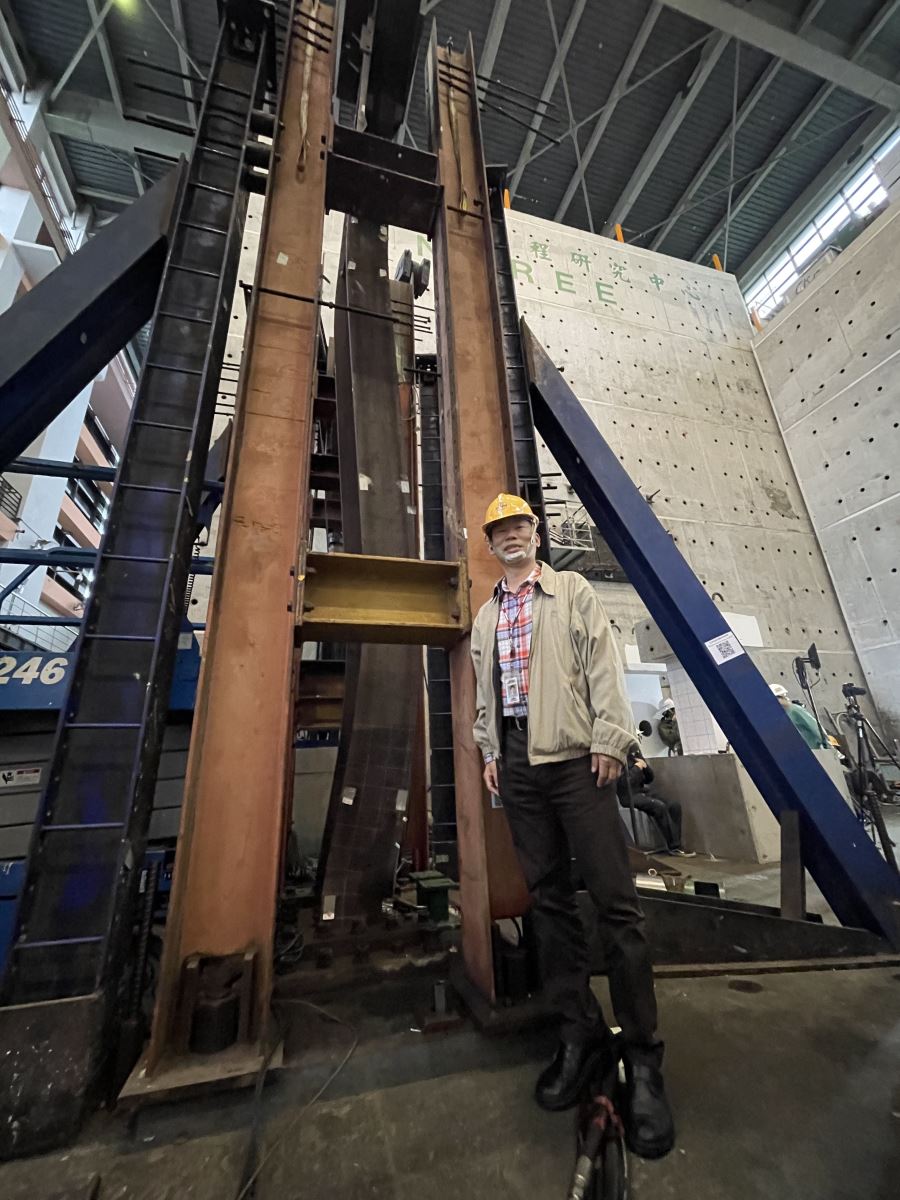
Picture 1: Director Chung-Che Chou posing with steal beams that were bent after an experiment
(Photo credit: Pei-Lin Lin)
Turning Earthquakes Into a Large-scale Lab
Normal people get scared when an earthquake strikes. However, the man standing before me, Director Chou, had a sparkle in his eye when he said, "At NCREE, we chase quakes.”
It's hard to imagine that while we’re still worrying about aftershocks, the people at NCREE are excited to get to work. As long as the epicenter has been confirmed, NCREE personnel can use information from six to seven hundred monitoring stations from the Central Weather Bureau to rapidly assess the potential damage to people and buildings within three minutes with an evaluation program developed by NCREE.
Director Chou’s cell phone also has a secret weapon. The numbers displayed on it are often more accurate than news alerts. As long as the number remains a "0" after an earthquake, everyone can rest assured there hasn’t been any damage. However, in the case of the 2022 Taitung Chihshang earthquake, the phone displayed a "3," causing everyone to remain on high alert. A “3” meant that NCREE’s assessment program predicted that the earthquake had potentially damaged three buildings. Furthermore, NCREE had access to directly transmitted data from the earthquake because the center had installed sensors in Taitung Tzu Chi Hospital, the Taitung Fire Department, and public hospitals. As such, approximately fifteen minutes after the earthquake, the Taiwan Structural Disaster Prevention Monitoring Platform automatically generated a "Rapid Preliminary Structural Assessment.”
Why does NCREE chase quakes? Director Chou explained that "The damage caused by earthquakes travels along the direction of the earthquake. Every time an earthquake occurs, it becomes a 'large-scale lab.' Our colleagues are split up into different areas to collect information in disaster zones and verify the shortcomings of the seismic prevention techniques we have studied over the years. Although many sensors have been tested in laboratories, the many variables that occur after a real earthquake such as voltage changes, deformations of buildings and bridges, and network connectivity issues, pose significant challenges. Therefore, whenever there is an earthquake, our colleagues must get to the scene to perform critical procedures such as assessing the damage to buildings, inspecting bridges, and ensuring our sensors are not damaged."
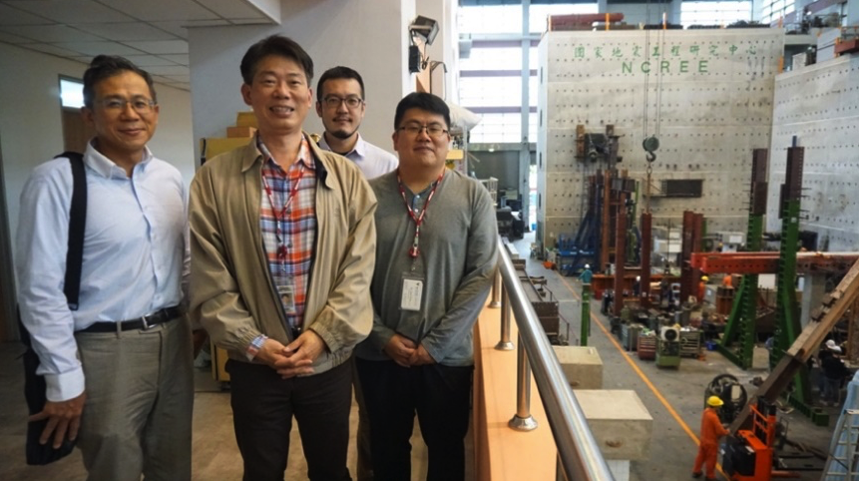
Picture 2: Director Chou and Chia-Han Chen, Shu-Hsien Chao, and Fu-Pei Hsiao AKA “The guys who chase quakes” posing together (Photo credit: Pei-Lin Lin)
Taiwan-Us International Experiments Simulate a Once-In-A-2500-Year Earthquake
In addition to actual earthquakes serving as large-scale labs for seismic engineering and disaster prevention techniques, NCREE has internationally renowned experimental sites in Taipei and Tainan. The building resembling a hollowed-out fortress mentioned at the beginning of the article is equipped with thick and sturdy reaction walls, while the ground is entirely covered with tough flooring. There is also a 3D earthquake simulation shaking table at the entrance.
Actually, at first, when standing on the second floor, the horizontal view of the experimental site was quite impressive. However, as Director Chou led us directly beneath the steel beams and columns of the reaction wall experimental system, the scale of the human body became strikingly small. The director explained that this simulation represents the effects of a once-in-a-2500-year earthquake. It portrays the potential behavior of the steel columns in modern buildings during a seismic event with a magnitude of seven or higher.
How difficult was performing this full-scale structural experiment? In fact, previous experiments in the United States had failed, so NCREE considered more complex variables and added more testing equipment and control techniques. Director Chou mentioned that in previous international experiments, researchers only focused on individual column components. However, beams and columns were combined in this three-year project conducted by NCREE, National Taiwan University, the University of California, San Diego, and the University of California, Berkeley. The displacement of the shaking was input into hydraulic jacks by utilizing the deformation of the beams to transmit forces to the columns and combining computer analysis to simulate seismic shaking. Researchers aimed to realistically simulate the most dangerous moments buildings are subjected to during strong earthquakes.
They successfully conducted the world's first laboratory experiment that reflected the behavior of life-sized beams and columns under high axial forces and the effects of earthquakes, including the buckling and lateral deformations that long columns may experience. Director Chou further explained that many buildings are called "shrimp casings" because, during earthquakes, the combination of the load above and the lateral forces often leads to damage, particularly at the ground level.
School Reinforcements in Thailand and Indonesia Provide a Safe Learning Environment for Students
Speaking of structural issues, three PhDs from NCREE, Chia-Han Chen, Shu-Hsien Chao, and Fu-Pei Hsiao, also discussed their involvement in several New Southbound Policy projects. Children in Taiwan are truly fortunate, as around 99% of junior high and elementary schools with formerly insufficient seismic resistance have undergone school reinforcement projects. As such, the researchers at NCREE hope to export the successful experiences gained in Taiwan to other New Southbound countries.
In 2020, they adopted a "column enlargement reinforcement" approach to strengthen the buildings of three schools in Chiang Rai of Northern Thailand. The three PhDs used their hands to demonstrate the shape of an "elephant leg" to explain the concept of column enlargement reinforcement. It involves transforming the columns into robust "elephant legs" to enhance their supporting capacity, thereby preventing the buildings from being structurally weak. Additionally, due to the concern for flooding in many Southeast Asian countries, their architectural designs often feature elevated houses with minimal usage of the ground floor, which becomes a structural vulnerability.
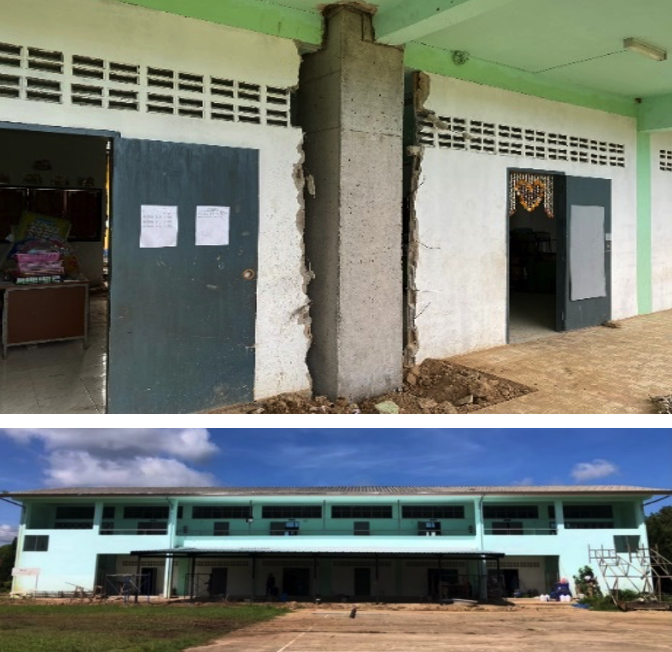
Picture 3: An example of a school reinforcement project in Chiang Rai, Thailand
(Photo credit: NCREE)
Despite being affected by the pandemic, NCREE has not stopped pushing forward. It has continued its collaboration with Bandung Institute of Technology, Indonesia to reinforce four school buildings, which were completed in May 2023. These demonstration projects in Thailand and Indonesia serve as examples. NCREE aims to inspire others and, through close communication with local engineers and academic institutions, understand the specific needs of each location. They develop reinforcement methods tailored to each country's requirements. For example, in Indonesia, where brick houses are prevalent, they adapt the reinforcement techniques to incorporate brick wall reinforcement, providing the most effective and beneficial solutions. They also organize workshops on school seismic reinforcement, which spread important knowledge. The team hopes that local engineers can learn from successful cases in Taiwan and avoid unnecessary setbacks. Even local Taiwanese businesses actively contribute financially and offer support, allowing Taiwan's seismic technology to benefit more children overseas.
Taiwan’s World-Famous Early Warning System for Seismic Activity
When it comes to earthquake prevention technology, NCREE has developed an on-site early warning system for earthquakes. Director Chou mentioned, "In some countries that are not financially well-off, it may not be feasible to establish hundreds of earthquake monitoring stations like in Taiwan. What can be done in such cases? The development of this system was aimed at addressing this issue. For example, if a village wants to have early warning capabilities, they can simply install an on-site early warning system, which can function as a monitoring station on its own, providing approximately five seconds of valuable early warning time."
This technology has previously been implemented in demonstration stations in India and New Zealand. In particular, in India, it was even installed near the world's highest peak, the Himalayas. This mainly involved collaborating with local earthquake research institutes and collecting seismic data from the region. The success rate of earthquake prediction exceeded 95%, and in New Zealand, it reached an impressive rate of approximately 98%.
Another achievement is the development of the "5D Smart City," a visualized intelligent platform created by NCREE. Since it is "visualized," it bids farewell to the traditional earthquake alerts that only display text on maps. This system couples aerial imagery and 3D maps so the shaking of the entire city during an earthquake can be instantly visualized. In the event of a major earthquake, unmanned drones and GPS-equipped rescue vehicles are dispatched in advance. Emergency response directors can utilize an immersive command and dispatch center, allowing for a more effective allocation of disaster relief resources and manpower.
Currently, disaster preparedness drills in Taiwan's counties and cities are conducted using this platform for situation simulation. What's even more remarkable is that despite being an earthquake system, it has unlimited possibilities. Taiwanese-owned factories in Thailand have transformed this platform into smart factory disaster management systems and subsequently held a results presentation in Bangkok. Additionally, in Thailand, there are concerns about water rising above statues in Buddhist temples after earthquakes. Using this 5D smart system, water level gauges are installed around the large statues of the Buddha. Along with aerial imagery, these gauges continuously monitor the safety of the Buddha statues and alleviate the concerns of local cultural and religious followers.
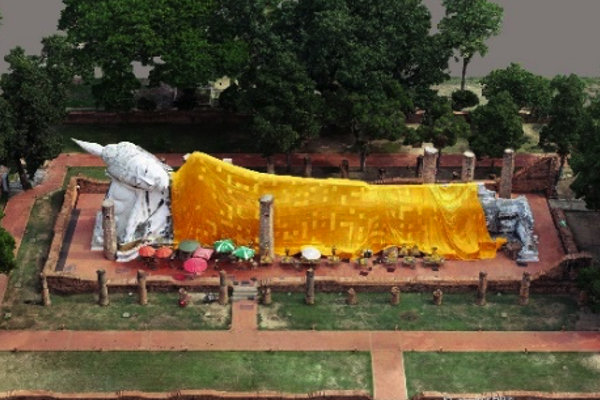
Picture 4: Application of the 5D Smart City Disaster Prevention and Rescue Platform in Thai tourist parks - Construction of a 3D model of a Buddha statue (Photo credit: NCREE).
Ultra-Sensitive Technology in Taiwanese Factories Needs Protection From Tremors as Far Away as Mexico
When mentioning a series of high-tech seismic technologies, it’s necessary to talk about "high-tech" earthquake protection. With Taiwan's semiconductor industry reaching new heights, going from 28 nanometers to 10 nanometers, and now advancing to 2 nanometers, the demand for earthquake protection has increased exponentially along with the precision of the semiconductor manufacturing process. Director Chou emphasized not to underestimate the significance of on-site earthquake early warning systems, which provide a five-second advance warning. Many high-tech factories in northern, central, and southern Taiwan have installed these systems. Although the warning time for southern factories may be shorter than other parts of Taiwan, these systems still allow for an additional buffer time of ten seconds for central and northern regions. This additional time can be utilized to shut down operations or minimize losses.
However, for increasingly sophisticated high-tech factories, the current challenge is to provide protection against earthquakes occurring outside of Taiwan. Director Chou gave an example. Last September, there was an earthquake in Chiayi, and some major factories in southern Taiwan were damaged. However, a few days later, a strong earthquake with a magnitude of 7 occurred in Mexico. Although the Taiwanese population hardly felt it, the long-period seismic waves from the earthquake in Mexico still had the potential to affect machinery in Taiwan. In the past, the manufacturing processes were only at the 10-nanometer or 12-nanometer level, but now they have advanced to 3 nanometers. Therefore, wherever seismic activity occurs, whether it be in Japan, the United States, or Mexico, there is a possibility of these tremors affecting high-precision machinery in Taiwan.
Therefore, the next challenge that NCREE is facing is not only the ongoing research and development of earthquake detection and early warning systems for specific low-frequency and long-period earthquakes but also the active development of cost-effective and high-quality sensors. In the past, reliance was placed on sensors from Japan, but if Taiwan wants to popularize their use, the country needs to achieve a good balance between price and quantity.
I can only say that the more I get to know NCREE, the more I admire every individual here who is dedicated to studying earthquakes. They are not just engineers or researchers; they are truly doing noble work. In the global efforts for disaster prevention, mitigation, and relief, they use foresight, knowledge, and goodwill to establish Taiwan's reputation in earthquake preparedness, showcasing not only their expertise but also their compassionate spirit.
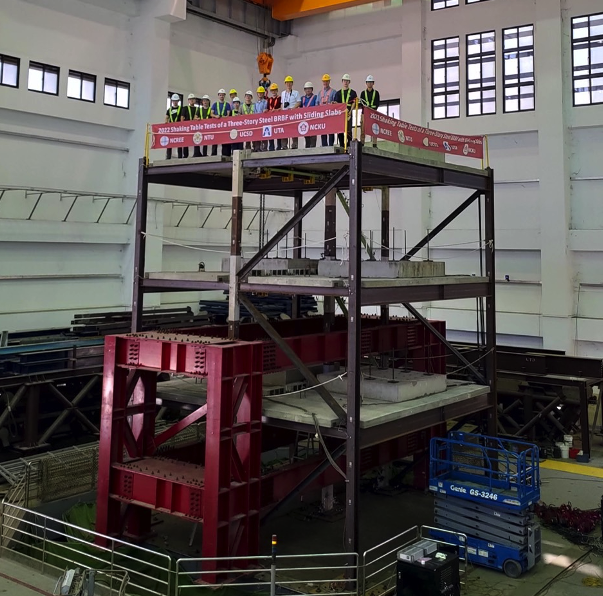
Picture 5: A steel braced frame (SBRB) structure is being tested on a shaking table to simulate the 2022 Taitung Chihshang Earthquake research during a Taiwan-US international cooperation project (Photo credit: NCREE)
Columnist
.png) Pei-lin Lin
Pei-lin Lin
Pei-lin Lin obtained her B.A. in Philosophy from Fu Jen University and her M.A in Political Science from National Taiwan University. Lin embodies a humanistic literacy and political sensibility. In recent years, Lin has collaborated with the Taiwanese government to shoot videos promoting various policies. Currently, Lin splits her time between running a Chan Lands Ltd., Zongdipan, making documentary films and hosting the podcast “Human Translation Machine.” In the past, Lin has been a reporter for several media outlets and the anchor of shows on TVBS, CBC and Da Ai Television. While at Da Ai Television, Lin’s piece “Muhammad Yunus- Savior of the Poor,” was nominated at the First Taiwan Golden Wheel Awards for Outstanding Television News Feature.